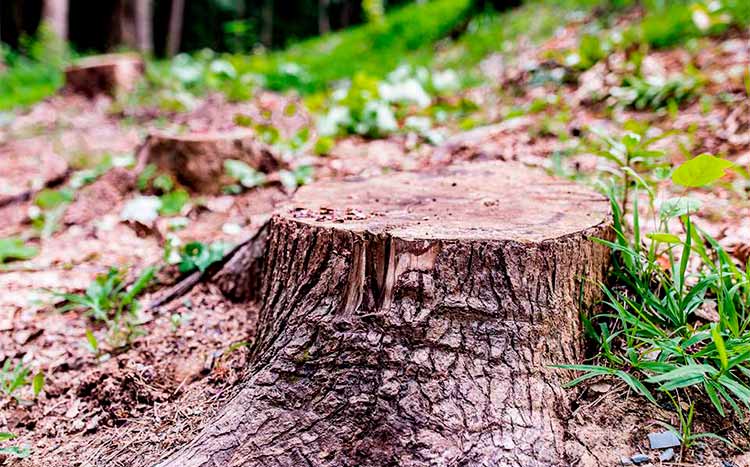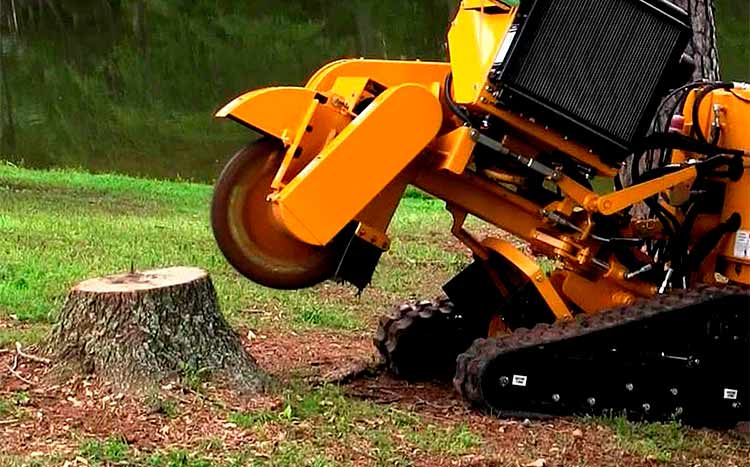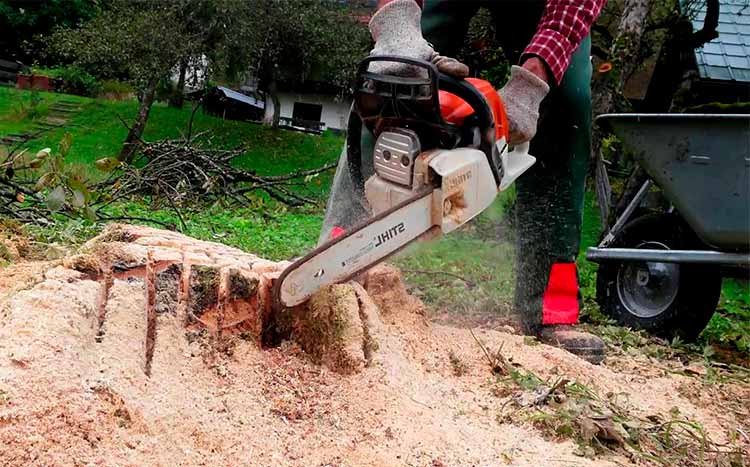Do you want to remove your stump but are unsure about the timing for its removal?
It is generally advisable to grind a stump out when it has been found to compromise both the visual appeal and the safety of your property. You can also do stump grinding if you want to grow other plants in the same area where the stump is located.
Winter is often considered to be the best time of year for stump grinding. This is because it guarantees lower prices for clients since it is an off-season for stump removal experts. Winter stump grinding1 also ensures the survival of surrounding plants by eliminating competition.

What we cover
ToggleWhat is Stump Grinding?
Stump grinding is the process through which a stump of wood is broken down into tiny pieces by a stump grinder’s rotating blade. This often results in reducing the stump to a level well beneath the earth’s surface.
It is usually advisable to use the chips of wood obtained from stump grinding for garden mulching. Experts also recommend filling the hole that remains from stump removal with the same wooden chips and some soil.
Types of Stump Grinders
Stump grinders come in a variety of shapes and sizes. They are usually selected based on a number of factors that include age, thickness, size, depth, and tree species of the stump. The different types of stump grinders include:
Handlebar Stump Grinders
The small size of handlebar grinders makes them rather easy to maneuver around. It also makes them quite suitable for grinding stumps in extremely restricted areas such as those that are closely surrounded by structures.
Handlebar grinders, otherwise known as walk-behind or hand-guided grinders are also quite easy to transport. They can even be folded to fit into the rear end of a minivan or truck. Their user-friendly controls also make them extremely easy to use.
Wheeled Stump Grinders
Wheeled stump grinders are sometimes referred to as rear-hitch stump grinders. This is because they are normally mounted on either single or multiple-axle vehicles.
These vehicles, also known as chassis, are usually connected to the tow bars of trucks using hitches. They are therefore transported through towing before being disconnected and navigated into place at the job site.
A wheeled stump grinder also possesses a rotating disk that shaves the stump from side to side in a horizontal fashion. This differs from vertical stump grinders which utilize a rotating augur to penetrate beneath the stump and discontinue any root growth.
Riding Stump Grinders
Riding stump grinders mimic riding lawn mowers and small tractors in appearance. Although they are quite user-friendly, riding grinders are not recommended for stumps with limited access such as those found on steep slopes.
They should also not be used in places with multiple stumps that are difficult to navigate between. Their use is thus quite dependent on the nature of the terrain and the proximity of stumps in the job site.
Skid Stump Grinders
Skid stump grinders are those with large continuous tank-like treads and an operator’s control booth that is either behind or above their lower structure. They are quite versatile since they can be linked to various stump grinder attachments for maximum performance.
What is the Difference Between Stump Grinding and Stump Removal?
Stump removal is usually regarded as a more thorough process than stump grinding. This is because it involves the removal of a stump together with all of its roots. This makes it quite damaging to the visual appeal of a landscape.
It is therefore mostly done in situations where a property’s aesthetic value is not really vital, for example, when clearing land before construction.
Stump grinding, on the other hand, is certainly less rigorous than stump removal. This is because it involves using a grinder to break down a stump into smaller chips of wood. This makes it a more effective process in terms of time, cost, and labor.
The wood chips obtained in stump grinding are also useful for mulching other plants. However, stump grinding does not completely remove all the roots of a stump. This makes it only suitable for increasing a property’s visual appeal since it does not provide an entirely clean slate.






Stump Grinder Renting
Although renting out a stump grinder is cheaper than hiring a stump grinding contractor, most experts do not recommend it. This is because of a variety of factors that have to be considered when renting a stump grinder. These include:
Factors to consider when renting a stump grinder
Safety
It is extremely vital for you to ensure that you possess both the required skill set and safety gear to operate a stump grinder before renting one. You should also subscribe to an insurance package that will cater for any injury and damage in case of an accident.
Transport and Gas
Stump grinders come in various shapes and sizes depending on the magnitude of the job in question. They normally require mini-trucks to transport them since they can weigh as much as 1.6 tons.
Gas is also required both for the vehicle as well as the stump grinder. This will certainly increase the cost of renting out a stump grinder by about $25 to $50 depending on the transportation distance and the size of the job.
Debris Disposal
Renting out a stump grinder often puts the liability of clearing any leftover debris on the DIY contractor. This can prove to be quite a task especially when dealing with multiple stumps. One may even have to hire some extra pairs of hands in order to completely clear any debris.
Labor
The large size of most stump grinders often demands extra personnel when it comes to loading, unloading, and maneuvering them. This will most certainly add to the cost of renting them.
DIY vs Professional Stump Grinding
Even though it usually costs much less to grind a stump on your own instead of hiring an expert, professional stump grinding is still more advantageous than its DIY alternative.
This is because it is safer for both the surrounding people and the property since it ensures that the specialized equipment such as grinders is handled by well-trained experts.
Most professional contractors also have an insurance policy that covers any injury or property damage. Professional stump grinding is also more cost and time-effective than DIY grinding.
GoTreeQuotes is a great tool that quickly matches you with the best stump-grinding experts in your locality. You can get three estimates from local stump grinding professionals in just under two minutes.
Kindly follow the steps below to enjoy this great service:
- Scroll to the top of the page and enter your zip code
- Answer questions about your stump grinding job
- Your stump grinding details are forwarded to three local experts who will send you a price estimate for your job with some friendly advice
Is it Cheaper to Grind or Remove a Stump?
Stump grinding is certainly cheaper than stump removal since it is less intensive in terms of labor and time.
Generally, stump grinding costs an average of $250 to grind a stump with a diameter of about 20 inches. This is certainly more economical when compared to the complete removal of the same stump which costs an average of $522.5.
However, these prices are not constant since they are dependent on a variety of factors which include size, species, location, and number of stumps to either be ground or removed.
Can I Build or Pave Over an Area Where a Stump Was Ground Out?
Yes, you can. You must however make sure that the ground is able to support whatever structure you intend to build over it. You can do this by compacting the soil and installing a concrete slab over it to act as the foundation.
Such a slab should not be installed over a stump that has simply been cut to ground level. This is because it will eventually develop multiple cracks as a result of the decomposition of the stump beneath it which is causing the ground to settle.
Circumstances When a Stump Cannot Be Ground
There are a number of circumstances that usually prevent effective stump grinding from taking place. They include:
Inaccessibility
An inaccessible tree stump is one that is found in an area where it cannot be reached for grinding. This is often a result of either roughness in terrain or lack of enough space for the equipment to function effectively.
Inability to Completely Grind
Where grinding is insufficient to completely get rid of a stump, experts usually recommend coupling it with skid steer excavation. This is however more expensive than regular stump grinding.
Proximity to Valuable Property
It is virtually impossible to grind out stumps that are too close to valuable property without damaging such property. Stumps that are extremely close to other useful vegetation, for example, cannot be ground without damaging the root systems of the surrounding plants.
Can You Remove a Stump Without Grinding it?
Yes, you can. There are other stump removal methods that are mostly utilized by DIY tree removers who cannot afford to pay for stump grinding. Such methods include:
Manual Stump Removal
Manual removal of a stump is often recommended when dealing with either small or medium-sized stumps. Stumps from old and diseased trees can also be removed using this technique.
Larger stumps from fresher trees are usually not removed through this method since doing so would take too much time and effort. The materials required for manual stump removal include a chainsaw, a pick mattock, a digging bar, a shovel, an ax, a truck, and a piece of chain.
| Materials Needed | Average Cost |
|---|---|
| Chainsaw | $150 |
| Pick Mattock | $30 |
| Digging Bar | $100 |
| Shovel | $24 |
| Ax | $36 |
| Chainsaw Chaps | $71 |
| Work Gloves | $14 |
| Safety Glasses | $13 |
| Work Boots (Steel Toe) | $100 |
| Total | $538 |
How Manual Stump Removal Works
- Using a mattock, loosen the soil around the stump by digging.
- Shovel out the loosened soil to reveal the roots underneath. Use a digging bar to clear out any hard pieces of earth that might be in the way.
- Use either an ax or the mattock end with an adze to sever the roots as you expose them.
- Once you reach the taproot, remove any excess dirt on it using either a hose pipe or a power washer before cutting it with an axe.
- Rock the stump to expose any remaining roots. Sever all the remaining roots until the stump is completely uprooted.
- If the trunk is too heavy to be rocked manually, tie a chain around it and connect it to a truck. Repeatedly drive the truck forward and backward to shake the stump until it is completely uprooted.
Chemical Stump Removal
Chemical stump removal is usually recommended when looking to remove stumps that are too large to manually uproot. It can also be used to remove small and medium-sized stumps if the client does not want to go through the grueling process of manual removal.
However, it is much slower than manual removal and could take up to one year to have the desired effect. Chemical stump removal basically involves accelerating the rate at which a stump decays.
This is normally done by keeping it moist while adding nitrogen to it in the form of chemicals such as nitrogen fertilizer and potassium nitrate. Apart from the chemicals, there are other materials such as a drill, a chainsaw, a plastic tarp, an ax, and garden mulch.
| Materials | Average Cost |
|---|---|
| Stump Removal Chemicals | $53 |
| Power Drill | $86 |
| Chainsaw | $150 |
| Plastic Tarp | $19 |
| Axe | $36 |
| Safety Materials like gloves, glasses, chaps and boots | $198 |
| Garden Mulch | $20 (Free when composted) |
| Total | $562 |
How Chemical Stump Removal Works
- Using a chainsaw, cut the stump down as close as possible to the earth’s surface. Your chainsaw should not strike the earth during this process lest it is dulled. Ensure you put on steel-toed boots and chainsaw chaps for this procedure.
- Using the power drill, bore several holes into the stump. Make sure the holes are close together and well spread out across the stump. Use the largest bit at hand to obtain the widest and deepest holes possible.
- Pour as much water and nitrogen-rich fertilizer as possible into each hole. You can also use stump remover granules instead of fertilizer.
- Create a moisture-retaining barrier over the stump by covering it with a plastic tarp. This should be done after saturating the ground around it with water and applying a thick layer of garden mulch above and around the stump.
- Apply a second layer of wet garden mulch on top of the plastic tarp and place weighty objects such as stones and potted plants over it. This will not only provide an extra layer of moisture but also keep the tarp from being blown away.
- Uncover the stump every fortnight and add more water and nitrogen to it before covering it again. Do this at the same frequency until the stump is soft enough to be broken up with an ax. This normally takes about 4 months.
- Any part of the stump that is still too hard to be broken up should be retreated with water and nitrogen before being covered. Once most of the stump has been broken up, you can bury whatever is left of it and let it continue rotting underground.
Stump Burning
Stump burning is perhaps the cheapest and fastest way to get rid of a stump. It is often recommended for medium and large-sized stumps as long as there is clearance from the relevant local authorities.
It usually takes a maximum of one day to burn out a stump depending on its freshness. Dry stumps often burn faster than their fresher counterparts. Stump burning can cost as little as $200 since it only requires some kerosene, a drill, a shovel, and safety equipment.
How Stump Burning Works
- Dig a trench of about 5 inches deep and 11 inches wide around the stump to keep the surrounding foliage from igniting.
- Drill as many wide and deep holes as possible into the stump. Ensure there is a hole at the center of the stump that is about 4 inches wide.
- Saturate the stump by repeatedly pouring kerosene into the holes. Fill the center hole with charcoal before setting the stump on fire from a secure distance. Make sure you have a fire extinguisher to deal with any stray embers.
- After the stump is entirely burnt, break up anything that is left over. Bury the remains where the stump once was.
FAQ's
Yes, you can. However, since grinding a stump using a chainsaw will not entirely get rid of it, you may need to cover the remaining stump with organic material such as soil so that it is not visible.
Most stumps are usually ground 8 to 12 inches beneath the earth. This is however dependent on a variety of factors which include the size of the grinder’s blade as well as the diameter and depth of the stump in question.
Larger stumps which require bigger blades and more time to grind are therefore more expensive to remove than their smaller counterparts.

- Rocky Mountain Tree Service, (2021) Can You Grind Stumps In The Winter? <https://rockymountaintreeservice.com/2021/11/can-you-grind-stumps-in-the-winter/> Accessed: 18-03-2024







